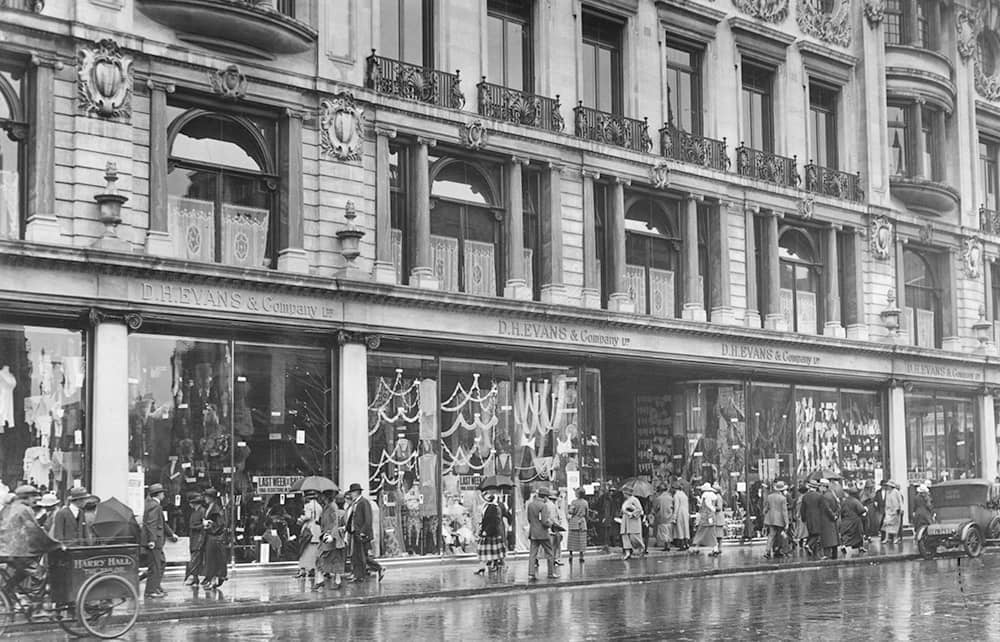There are two journeys I’ll need to make after reading Tessa Boase’s heartbreakingly poignant book about London’s lost department stores. First, to Mile End, to see the tiny Georgian building bang in the middle of the pillared façade of what used to be Wickhams and is now Tesco and Sports Direct. During Wickhams’s 1920s expansion, one neighbour, a German clockmaker called Otto Spiegelhalter, simply refused to budge, whatever the financial offer. He eventually agreed to sell his garden so that the store could expand round the back of him. But there, dwarfed by the clock tower, his two-storey house still stands, a monument to stubbornness.
Next, Khan’s Bargains in Peckham Rye, which used to be Holdrons, ‘the Pride of Rye Lane’s Golden Mile’, to which 1930s children flocked to see the largest model railway display in Europe. The photographs in this charming book show us not only Khan’s bargains, which look tempting, but also the man, Akbar Khan, who arrived from Afghanistan in 1999 and is now ‘on a mission to help get more traders involved in preserving Peckham’s architectural heritage’. Well done him. Above his head you can see the Art Deco vaulted ceiling made of ‘lenscrete’ (concrete dotted with a thousand glass lenses) from Holdrons’s 1930s rebuild. The building is a modernist gem.
Store owners knew that if they ensnared children they would hold on to them as customers for life
You’ll need a robust constitution to read this chronicle of the rise, decline and death of the family-run department store without weeping. These proud establishments might have been rabbit-warren-like if you were on the second floor searching for the soft furnishings, but they were also strangely glamorous, with their doormen and their staircase halls. The excitement of visiting one with one’s mother was a defining aspect of countless childhoods. The owners knew that if they ensnared children they would hold on to them as customers for life. The Peter Pan playground at D.H. Evans was a thrill, with its indoor treehouses and ponds, but the escalator hall to get up there was just as dazzling. Even the horror of being kitted out in the school uniform department at Daniel Neal in Oxford Street by the formidable Mrs Boyce with her jangling bangles was assuaged by the sensual tingle of having your feet X-rayed in the shoe department.
‘The Wonder Store of the South’ was how Kennards of Croydon was described; and these places were indeed wonders of capitalism. The public came not only to buy but to gawp. ‘Shopping,’ declared Harry Gordon Selfridge’s advertisement in his Edwardian media blitz to promote his new store, should be ‘a pleasure – a pastime – a recreation’.
Department store owners became quite puffed up, as well they might. When Arthur Gamage, the founder of Gamages in Holborn (not to be confused with Gorringes in Buckingham Palace Road) died in 1930, he lay in state on a catafalque in his motoring department, his staff members standing guard day and night. His motto had been simply: ‘Undercut the competition’.
The general trend was this: unheard of provincial apprentice (William Debenham, Alec Simpson, Dan Evans or William Whiteley) arrives in London in about the 1850s and opens a small shop. Victorians flock. Larger building built, copying architecture of, say, the William and Mary façade of Hampton Court. Money pours in. Sales staff housed in dormitories in the attics, under a ‘live-in’ system, whereby they’re paid half in cash and half in board and lodging. At some time there’s a terrible fire in which a handful die. Massive expansion in the 1920s and 1930s, in daring architecture. Stunning new escalators and lifts installed. Even larger shops take a ‘controlling interest’ in the business. Second world war: façade bombed. Post-war: trysts. ‘Meet me under the clock at Bourne & Hollingsworth’, or ‘outside Swan & Edgar’. Shops starting to look dowdy by the 1970s. Cling on; still just about going in 2016. Close last year. Local person comments that ‘the heart has been ripped out of the high street’.
If you can face reading through these repeated stories of glory followed by decline and demise you’ll relish Boase’s book – and the photographs. My favourite three are: schoolboys and men in 1936, gazing at model trains going round and round at Gamages the week before Christmas (spot the clergyman among them all, his white dog-collar glinting); the interior of Robinson & Cleaver, taken in 1910, reminding us just how important lace was to all aspects of British domestic life, from curtains to clothing; and one captioned ‘A snatched rest for shop assistants in “Room Six” at Harrods, 1920,’ which shows about 100 shopgirls easing their weary legs and either knitting or reading a hardback book.
Selfridge’s doesn’t have its own proper section in this book because it has survived. Neither does Harrods, nor, thank goodness, John Lewis. (When my beloved Peter Jones goes, I go.) But we should take none of these places for granted.






Comments